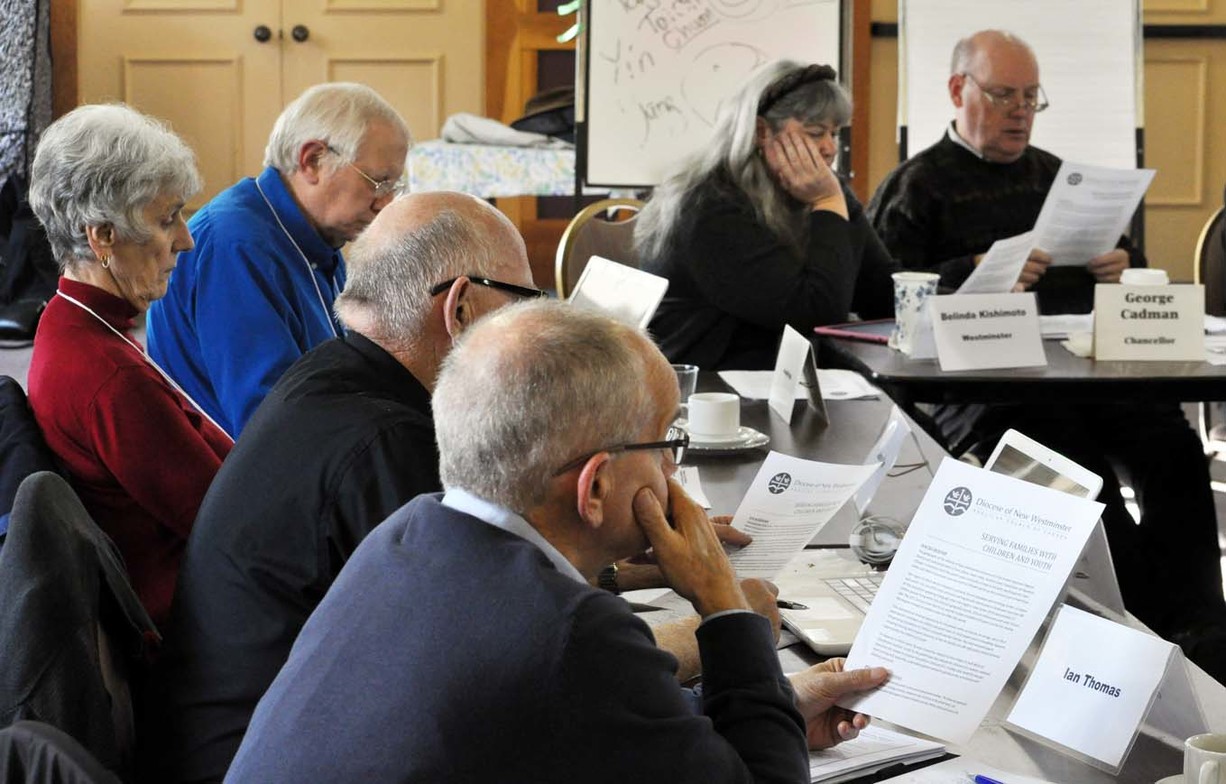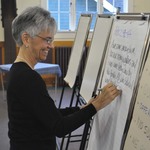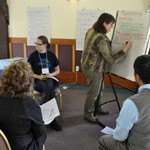The Diocesan Council retreat, development, learning session and business meeting was originally scheduled to take place at St. John, Shaughnessy on November 1st, 2014, but due to some plumbing and heating issues at the Nanton Street church the session was moved to the Parish Hall of St. Mary’s, Kerrisdale (SMK). This was a very pleasant environment for the meeting and Council was grateful to rector, the Reverend Jeremy Clark-King, parish and staff for making the space available.
The day began at 9:30am with Opening Worship led by the Reverend Janice Lowell. The reading for the day PHILIPPIANS 4. 4-9 was read and the reading followed by a brief bible study on the passage. The theme of the worship and for that days meeting was contained in the prayer that closed the intercession section of worship prior to the Bishop’s blessing:
Lord, give us wisdom before we speak,understanding while we listen
sensitivity towards those we meet
and the perspective of your kingdom
in which to see the things of the earth.
At 10am, Agenda Committee member, Maureen Simons facilitated an introduction to the day looking at: Agenda, Meeting Norms and a re-cap of the last meeting. This produced some discussions about process and information availability from the meetings. Sandra Stevenson of Synod Staff suggested that the Minutes of the meetings be made available earlier than just prior to the next meeting. This was met with general approval.
Following Maureen’s introduction, Mark Munn presented the purpose of the day and identified the goals of the day:
- Purpose: By observing our work in spiritual practice, we develop a common vision for Diocesan Council within the context of a Christian Community
- The goals of the day were to articulate why we, the Diocese, are making Parish Development a priority and to explore how the Diocese is a Parish Development system.
The Bishop presented her perspective on the question “Why focus on Parish Development?”
The Bishop summed up her presentation saying, “Every diocese is in the business of Parish Development. It is the primary task of a diocese”
Following the Bishop’s initial address a working definition was distributed:
Congregational Development is the development of congregations of all sizes, locations and conditions into more faithful, healthy and effective communities of faith that are:
1. Focused on and faithful to their unique reason for being/primary task as local expressions of the Body of Christ whose purpose is:
a) to assist God in the gathering of people into a community of faith,
b) to renew people in their baptismal identity and purpose, to transform them more and more into the image of Christ, and
c) to send them into the world to be God’s presence and to enact God’s purpose in civic life, social and family life, and in life with the Church
2. Connected to and expressive of their unique ecclesial tradition, ethos and character
3. Self-renewing and responsive to the challenges and opportunities before them in a way that leads to effective action
4. Sustainable or working toward greater sustainability in terms of a fit between the elements of their organizational life: vision for ministry, leadership, culture, size, property, finances, relationship to the community etc.
Bishop Melissa spent some time looking at and adding emphasis to Brian McLaren’s Address to the Diocese of Washington. Notes relating to that address were circulated, please click this link to download.
“Parish Development is for all parishes, not just those that are hurting or in decline”
The Bishop continued in her presentation with an analysis of challenges and opportunities that currently exist in parishes of all sizes: from the role of children in the worship; to the amount of clutter that is present in our buildings; to financial fitness; to the physical size and location of church buildings.
At 10:40am Council divided into dyads to practice engaging in conversation about Parish Development; what it means and why we the Diocese are engaging in it. After 10 minutes a number of Council members addressed the plenary reporting back about their discussions until 11:05 am when the first break of the day was announced.
Following the break, the Elements of an Organizational System (Model 7) flowchart aka “the Hairball Model” was distributed to members of Council. Bishop Melissa also drew an organic version in different coloured markers on a piece of flipchart paper.
Bishop Melissa began by saying that we are working in a “system” and we need to be aware of that. There are many theories on organizational development as to the role of systems. In a system everything is related to everything else and that creates its own energy and the energy of a system that is adopted.
The climate of our diocese reflects that we have been through some difficult times and that reality influences and determines the culture.
In describing the diagram, STRATEGY is at the top. The Bishop then went through each item on the chart and how it relates to the whole system. All the categories are set within the inner circle of CULTURE and CLIMATE and the encompassing circle of EVIRONMENT being today, November 1st, 2014, in the Lower Mainland of British Columbia, Canada.
The Bishop then distributed the Elements of a Diocesan Parish Development System flowchart diagram and gave a brief overview of each dialogue box and asked for comments or questions about the Elements model. The plenary again divided up into groups of two to ask each other questions about the chart. Then it was time for highlights of those small discussions to be brought back to the group.
There were some criticisms of the model: lack of biblical context; lack of support and encouragement for lay staff in parishes; unclear regarding connectivity to parishes, particularly those parishes who are on the geographic outreaches of the diocese.
The next phase of the Systems discussion consisted of designated groups of 4-5 Council members with one person chosen to be a recorder and one to be a facilitator discussing Parish Development Systems and exploring in detail three points: Barriers, Opportunities and Resources.
The plenary broke for lunch at 12:30pm and at 1pm the reporters for each group went over the items listed by their groups for each of the three categories. The results were collated and commonalities recorded. In summary:Barriers:
- Culture of fear and scarcity
- Seen as “gatekeepers”
- Fear of independent thinking
- Resistance to change
- Suspicion of Synod Office and Diocesan leadership
- Geography and time available
- Communication
- Institutional geography or process of putting ideas into actions
- Finances
- The “holy huddle”
Opportunities:
- Technology
- Social media
- Leadership
- Moment of “newness” – hopeful climate
- Chance to fix structures to work for us
- The Bishop
- New Vision
- Expertise from Synod Office staff, Bishop and leadership school
- Diversity
Resources:
- Technology and social media
- Existing expertise
- Training and personal development
- New Bishop
- Skilled people
- New volunteers
- Gifts as Anglicans
At 1:30pm, facilitators Maureen Simons and Mark Munn of the Agenda Committee asked Council to write down their next steps preferences for making Parish Development the key work of the Diocese:
Next Steps:
- Ensure that everyone in the Diocese becomes aware of parish development
- Consultation with parishes as to how this is a priority. Need for people in parishes to accept this as a priority.
- Need for a social media strategy reaching out to all people under 35 years of age.
- Need to change parochial reports asking for who is the person responsible for parish development.
- The process we have done today as Diocesan Council should be carried out by Parish Councils or through deaneries or archdeaconries.
- Each Archdeacon representative to send out a report about today.
- How will we ensure that we listen to parishes’ ideas about parish development?
- Partner with diverse parishes (clergy and lay) – communicate with them given that there are ever increasing populations.
- How to address fear in parishes where populations are decreasing?
- Strategy to actively involve Synod delegates in what we have done today.
- ‘In between’ Synods involves training.
- How do we get young people involved if they cannot afford to live in the City of Vancouver?
- Reach out to refugee, immigrants and economically marginalized (homeless).
- Continue to initiate and report the results.
- Communications strategy around how we transmit this message.
Of the above, the it was determined that the priorities are:
- Communications strategy
- Technology and social media strategy to reach out
- Partner with diverse groups
- The Bishop’s encouragement to continue to experiment and implement while we reach consensus
- Teaching personal development throughout the Diocese
- Engaging the whole of the Diocese
BUSINESS MEETING commenced at 2:10pm
THE MINUTES of September 9th, 2014,
The Minutes were adopted with some minor changes that did not affect the content. NEW! The Minutes now contain the results of email polls.
ORGANIZATIONAL STRUCTURE AND STEERING COMMITTEE
The Chancellor, George Cadman took some time to clarify the post-Synod 2014 structures of Diocesan governance. George began by pointing out that the Registrar, Donald Paul is the author of the content around this material. George informed Council that there has been some feedback and questions about the Steering Committee (consisting of: Bishop, a legal officer {Chancellor, Registrar or Legal Assessor}, Treasurer, Chair of the Standing Committee for Mission and Ministry Development, three members elected from the membership of Diocesan Council together with ex-officio members without voting privileges: the Executive Archdeacon {unless already a member}, and the Business Administrator). He encapsulated the Steering Committee’s function by saying that it is the Council meeting between Council meetings. The Steering Committee is intended to become an executive committee of Council not necessarily with full decision making powers of Council but with the ability to streamline information and issues and identify what progress is being made and next steps. The Steering Committee is an expediter of issues that come in front of Council.
The Standing Committees have the ability to bring issues to Council. Diocesan Council remains the decision making body of governance between Synods.
Registrar, Donald Paul restated the content of Regulation 18 about telephone meetings and email polls and the length of times designated for those email polls. He stressed the need for Council to participate as 60% of Council need to respond and 75% of that group needs to respond favourably for the motion to pass. These numbers are now shown in the Minutes
Donald Paul reminded Council that members do have the right to say that they do not want to vote on a particular item by email. When that happens, Council will then need to arrange to meet either in person or by telephone prior to voting.
FUNDRAISING FOR CHILDREN & YOUTH MINISTRIES
Diocesan Director for Stewardship and Gift Development Glen Mitchell was present for the next section of the business meeting.
Ministry for Children and Youth is a key component of Parish Development. Involving Children and Youth in ministry and in the life of parishes is very important. Glen reported on a number of statistics about the increasing numbers of Children and Youth in our communities. This data presents an exciting opportunity.
It was explained that the D of NW had already hired a full-time Coordinator who will begin on December 1st, 2014, and funds have been allocated for 2014 and 2015. However, we need additional resources to support the program in 2016 and 2017, as well as funding for training and program materials for parishes.
The overall cost for funding these initiatives is $100,000 per year through 2017 and the Diocese is launching a major gift effort seeking financial support for this work.
The Bishop got the fundraising ball rolling by writing a cheque for $1000 that was matched by Glen.
FINANCIAL STATEMENTS
Treasurer Bob Hardy reported that the finances of the diocese continue to be in good shape and directed council to the executive summaries for August and September, 2014. Business Administrator Rob Dickson addressed Council and said that a good deal of credit for the sound finances of the diocese should go to the structures: Diocesan Council , the two Standing Committees and Synod Staff for prudent use of diocesan financial resources.
Prior to conducting the meeting evaluation, closing prayers and dismissal, Cameron Gutjahr asked that the Minutes reflect hearty congratulations and a warm welcome to new Synod staffers, Children and Youth Ministry Coordinator, Caitlin Reilley Beck and Indigenous Justice Ministries Coordinator, Brander McDonald.
The meeting was dismissed following prayers at 3:35pm
Proposed next meeting dates in 2015: January 20, March 17th, April 28th and June 2nd.
Images:
1. Mark Munn reports back from the small group discussion on Parish Development Systems.
2. Bishop Melissa prepares the Bible Study for the Opening Worship.
3. Bishop’s representative on Council, Valerie Casselton chats with Archdeacon representative, the Venerable Stephen Rowe prior to Opening Worship
4. The Reverend Trudi Shaw, David Swan and Mark Munn listen to the Bishop’s presentation on Diocesan Parish Development Systems
5. The "Hairball" Model
7. Cameron Gutjahr and the Reverend David Price
8. Small group discussion
9. Preparing the flipchart to report back on the three points: Barriers, Opportunities, Resources
10. The Chancellor and the Bishop
11. Glen Mitchell presents "Serving Families with Children and Youth" program objectives.
12. Council carefully considers the "Serving Families with Children and Youth" content.
PHOTOS: Randy Murray
DIOCESAN COUNCIL
Diocesan Council, consists of the following voting members:
(a) the Diocesan Bishop or, when applicable, the Bishop’s Commissary or the Diocesan Administrator;
(b) the two most senior Legal Officers in attendance (being in order of seniority the Chancellor, the Registrar and the Legal Assessor);
(c) the Treasurer (or the Assistant Treasurer in the absence of the Treasurer);
(d) the Chair of Ministry and Mission Development Committee;
(e) two members chosen by the Dean and Archdeacons of the Diocese from their number.
(f) one Ordained and one Lay person may be appointed by the Bishop who shall continue in office, at the pleasure of the Bishop, from the time of appointment until the final adjournment of the regular Synod next following appointment.
(g) two persons from each Archdeaconry, one Lay and the other Ordained, who shall be elected at Synod
(h) two persons from the Diocese elected at least 15 years of age and less than 26 years of age, at the time of the election.
together with the following persons who shall be ex-officio members without voting privileges:
(i) the Executive Archdeacon if not already a member under sub-paragraph (e);
(j) the Business Administrator;
(k) the Director for Mission and Ministry Development;
(l) the Legal Assessor unless attending as a member under sub-paragraph (b)
(m) the Assistant Treasurer unless attending as a member under sub-paragraph (c); and
(n) a recording secretary appointed by the voting members of Diocesan Council.





















